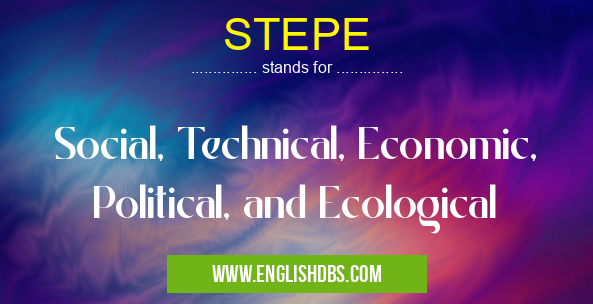What does STEPE mean in COMPUTING
STEPE is an acronym that stands for Social, Technical, Economic, Political, and Ecological. It is a framework used to analyze the external environment that a business operates in. By understanding the STEPE factors that are relevant to a business, it can identify opportunities and threats, and develop strategies to address them.

STEPE meaning in Computing in Computing
STEPE mostly used in an acronym Computing in Category Computing that means Social, Technical, Economic, Political, and Ecological
Shorthand: STEPE,
Full Form: Social, Technical, Economic, Political, and Ecological
For more information of "Social, Technical, Economic, Political, and Ecological", see the section below.
Social Factors
- Demographics: Age, gender, education level, income, and lifestyle of the population.
- Culture: Values, beliefs, norms, and customs of the society.
- Social trends: Changing attitudes and behaviors of the population.
Technical Factors
- Technology: New technologies, advancements, and their impact on the industry.
- Automation: Use of technology to replace human labor.
- Research and development: Innovation and new product development.
Economic Factors
- Economic growth: Rate of economic growth and its impact on the industry.
- Interest rates: Cost of borrowing money and its impact on investment.
- Inflation: Rate of price increases and its impact on consumer spending.
Political Factors
- Government regulations: Laws and regulations that affect the industry.
- Political stability: Level of political stability and its impact on business operations.
- Trade agreements: Agreements between countries that affect the import and export of goods and services.
Ecological Factors
- Environmental regulations: Laws and regulations that protect the environment.
- Climate change: Impact of climate change on the industry and the environment.
- Natural resources: Availability and cost of natural resources used by the industry.
Essential Questions and Answers on Social, Technical, Economic, Political, and Ecological in "COMPUTING»COMPUTING"
What is STEPE analysis?
STEPE analysis is a strategic planning tool that considers the impact of five external factors: Social, Technical, Economic, Political, and Ecological. It helps businesses anticipate and respond to changes in their operating environment.
How is STEPE analysis used in business planning?
STEPE analysis provides insights into potential opportunities and threats. By identifying and assessing these factors, businesses can develop strategies to adapt to changes, stay ahead of the competition, and achieve their goals.
How can businesses use STEPE analysis effectively?
Businesses can use STEPE analysis by:
- Identifying factors that may impact their operations.
- Assessing the potential opportunities and threats presented by these factors.
- Developing strategies to mitigate risks and capitalize on opportunities.
- Continuously monitoring and updating their STEPE analysis to stay informed about changes in the external environment.
What are the limitations of STEPE analysis?
While STEPE analysis is a valuable tool, it has some limitations:
- It can be difficult to predict future changes in the external environment with certainty.
- The factors considered in STEPE analysis are often interrelated, which can make it challenging to identify the most significant influences.
- STEPE analysis is based on publicly available information, which may not always be complete or accurate.
Final Words: The STEPE framework provides a comprehensive understanding of the external environment that a business operates in. By analyzing the relevant STEPE factors, a business can gain insights into the opportunities and threats that it faces, and develop strategies to address them effectively. Regular monitoring of the STEPE factors is essential to ensure that a business remains adaptive and responsive to the changing external environment.
